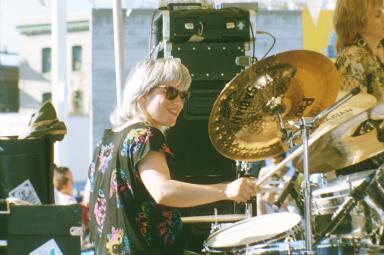
Goerlitz, a founding member of the Blazing Redheads,
now covers traps in the Wild Mango line-up
World Beat
Report Santos
Delgado Tanaka
Wong Vitale
Quon
Almeida
Gaffney Directory
BLAZING AWAY

Goerlitz, a founding member of the Blazing Redheads,
now covers traps in the Wild Mango line-up
Michelle Goerlitz
More than a decade ago, Michael Goerlitz was one of several musicians brought together on a moment's notice to fill a vacancy left open by the denial of visas for a Nicaraguan band scheduled for an appearance at Berkeley's La Peña. Too little time to rehearse left the group with a play list of only six selections, but allowed sufficient opportunity to discover that this chance circumstance had convened a group of kindred spirits whose tastes and talents clearly encouraged further collaboration. The Blazing Redheads emerged shortly thereafter, with Goerlitz covering conga and timbales in an ensemble that quickly distinguished itself through a jazzy, Latin-inflected sound into which funk, free jazz and numerous other stylistic elements were freely and seamlessly blended. Following a long run with the Redheads that found the group captivating audiences from San Francisco's Mission District to the East Coast's Miami Beach, as well as releasing a string of widely heralded recordings, Goerlitz continues to pursue her characteristic mix of musical eclecticism and professional polish as a core member of the Bay Area's Wild Mango.
WBR: Did your life as a percussionist take root in the Bay Area?
GOERLITZ: No. I grew up in southern Indiana. My dad was a drummer, a rudimental drummer. Rudimentary drumming has its roots in military drumming style. Drum and bugle corp. There=s a whole system of rudimental figures that you practice slow to fast, say, different rolls of different duration. There will be a five-stroke roll, a seven-stroke roll, a nine-stroke roll. It=s used in classical music. The way the music is written there are different rudiments included inside the music. My father got me started on the track. But what was most important was the support that both my parents gave me. I always knew I wanted to play drums, and as soon as I could, I did.
In college I studied classical percussion for three years. I got this wide range of exposure to some of the world=s great classical percussion. I was into mallet percussion at the time. Mallets are employed on instruments that are melodic, that have a keyboard: xylophone, vibes, marimba, which are widely used throughout the world. I did some orchestral shows. They would give me this book and I=d just have to sight readCthere wasn=t time for anything else. It was really high pressure. It was great but it was hard too.
I left college because I knew I didn=t want to become a music teacher, and if you didn=t want to teach, it was performance within the classical mode. I really felt stifled by the structure and the regimen of classical music. I started hearing music that, at the time, I thought didn=t have anything to do with classical music: Brasilian, jazz, Afro-Cuban music . . . .
WBR: And what do you think now?
GOERLITZ: The first thing that comes to mind is the Cuban danzón style. It=s a synthesis of European harmonies and Cuban rhythms, elegance combined with the more rhythmic percussion. In Brasilian music, there=s a beautiful style called chorro, which usually incorporates guitar, mandolin, clarinet and/or trombone. Its main percussion instrument is the pandeiro (Atambourine@ in Portuguese). It=s a style that also has classical elements.
Anyway, the first time I played a conga I was 18 years old. I heard it and just loved the sound: wow, there=s a whole other world. I thought, AI=ve got to check it out.@ I tried seeking out that other world in Indiana but it just wasn=t happening there. I tried seeking out other conga drummersCforget it. I decided then I had to leave. It was either the East Coast or the West Coast. I hate cold weather: I=ll go to the West Coast. I had heard great things about San Francisco and its music scene, so I took off. That was in 1980.
I had heard of this Bay Area band called Alive. It was an all-woman jazz
group, with one album that I had heard. That band was active for seven or eight
years. They just resurrected and have performed some gigs. I sought out their
percussionist, Carolyn Brandy. Her name was in the phone book, so I called her.
She said, Ayeah, I teach.@
So that=s how I started learning
conga, studying with Carolyn. She=s
great. She is a friend, mentor and role model, as far as women percussionists
go. She had her own group, the Carolyn Brandy Band. She does a lot of stuff with
kids. She taught at the Berkeley Arts Magnet
for some ten years.
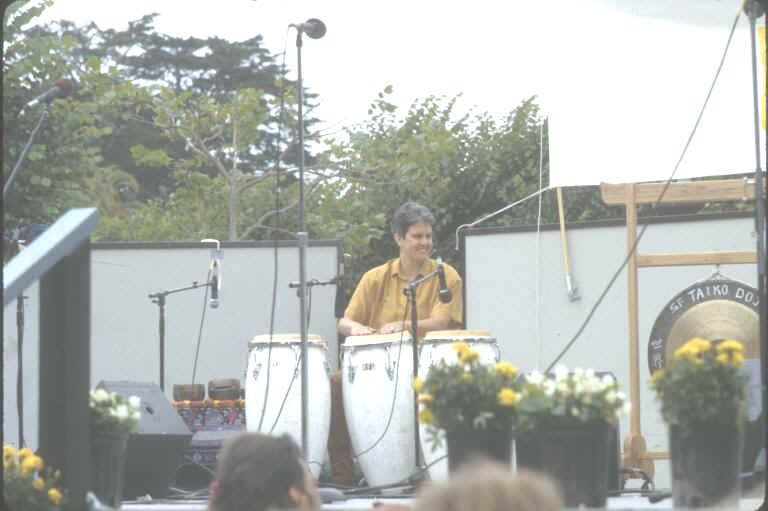
Carolyn Brandy, covering congas
at the World Drum Festival, and
WBR: Were there others teachers?
GOERLITZ: Chalo Eduardo, who I studied with for a long time. He=s
an inspiration to a lot of people here on the Brasilian music scene. John
Santos. And I studied with Mingo Lewis for a while. I think he=s
originally from New York. He=s played
with Chick Corea and Al DeMeola. He played with The Tubes for a few years. He=s
one of the strongest drummers that I=ve
every played with.
Chalo Eduardo, leading Brasilian
Beat, and John Santos, of the Machete Ensemble,
were among Goerlitz's teachers.
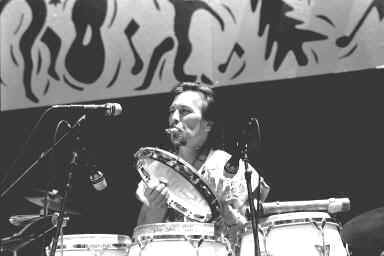
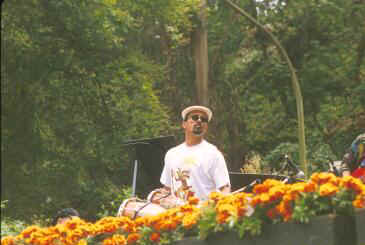 WBR: So you arrive in 1980 and find teachers and mentors. What about
gigs?
WBR: So you arrive in 1980 and find teachers and mentors. What about
gigs?
GOERLITZ: I played for about a year with this group called Ear To The Ground. It was a learning group. We got together and had different drummers come in and give us classes. We performed a little; the rhythms were in the Afro-Cuban style. Judy Graboyes; she used to play with the Blazing Redheads. Nancy Issenman. Susan Huff, who=s a terrific shekere player, and Hillary Hurst. I also spent some time with Sistah Boom, an all-women samba group started in 1980 under Carolyn Brandy=s direction.
That was followed by a group called Subject To Change, a jazz-funk-r=n=b band. We played with a terrific drummer from El Salvador, Pepe Jacobo. He=s excellent; one of the best trap drummers in the Bay area. He is a bad Latin player. He plays the best samba and he=s very versatile also. After Subject To Change, I got into an acoustic group called Leopard Set. It was before its time. We combined jazz and folk and a lot of stuff you later saw happening in the commercial world. But then it was a couple of years before its time.
While I played with Leopard Set, I realized that I wanted to get back to more roots-Latin-Afro music. So I joined Grupo Sinigual and stayed with them for a couple of years. Grupo Sinigual was around for about eight years under the direction of Maria Medinia-Serafin, a local salsa musician-singer. I have a lot of respect for her, keeping that band together for all those years. It=s a big job; a salsa band is usually 10 or 12 musicians. She worked with all the best musicians she could get.
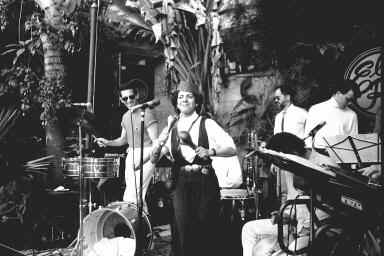
Maria Medinia-Serafin at the helm of her Grupo Sinigual
At the same time I was playing with Bahia, a band with Patricia Thumas, an excellent jazz and Latin keyboard player. I was making it financially solely on music then, because I was playing with all these different groups. That was also when the Blazing Redheads started. So I was in three different bands, really busy. But eventually I narrowed it down to the Blazing Redheads.
WBR: How did the Redheads come together?
GOERLITZ: We got together on a fluke. A band called Swing Shift had attempted to bring a Nicaraguan group up here for a double bill at La Peña. This was roughly in 1986. The band couldn=t get visas and canceled. So Swing Shift=s bass player phoned Judy Graboyes, who initially was the other percussionist in the Blazing Redheads and who I knew from Ear To The Ground. Judy called everybody else, including me. A group of us got together for what was supposed to be only one night. We learned six original songs or arrangements. When we were done playing, the audience was saying, Aloved it, play another one.@ We had to say, AWe don=t know another one.@
We had such a good time, we decided to continue. We had to scramble to learn material quickly, because we were getting gigs before we had enough material to play. That=s just the way it happened. Five years later it took off into a much different sound, but that=s how it started, unplanned.

Donna Viscuso and Klaudia Promissi formed
the wind section of Blazing Redheads line-up
WBR: How would you describe the evolution of the sound?
GOERLITZ: We were never straightforward anything, though, in the beginning, the largest influence was Latin. That had been one of my favorite things about the Redheads, the exchange of ideas and musical styles. Sometimes it was really a struggle to get the different kinds of music to meet, to get everybody to agree on how we=re going to do it. But the end result was always worth it.
WBR: What are the backgrounds of some of the other Redheads?
GOERLITZ: Donna Viscuso plays alto sax, harmonica, flute and piccolo. She comes from a jazz and free music background. She really likes avant-garde. She was the zanier one in the band in her musical tastes. She listens to Albert Ayler, a sax player, and John Zorn, who=s this really wild sax player. She loves that kind of stuff and likes mixing progressive grooves in with it. Klaudia Promissi comes from a jazz and rhythm-and-blues background. She plays tenor and soprano saxophone and flute. She and Donna had been horn partners for eight years. They played in Group Sax before the Blazing Redheads. Danielle Dowers was our drummer. She came from a fairly straight jazz background. We were the core of the band. We also played with Patricia Thumas, who I played with in Bahia. She was mainly a Latin player, but she branched out more when she started playing with us.
WBR: So the Blazing Redheads got started on a fluke. Was there a time when it became clear that the Redheads= music was going to have broad audience appeal?
GOERLITZ: We opened for Tower of Power at one time. It made me think, we can do it; we can get out there. Then we did a this tour of North Carolina, Georgia, New Orleans, and Miami. I thought: this will be a test; audiences in the Bay Area are used to are more eclectic stuff; we=ll see how it goes over now.
At most stops, people liked us even though they weren=t very familiar with the kinds of music that we were playing. When we got to Miami, they knew. I love Miami. They know how to dance to the music. And they accepted that we played more than Latin music. We played a bunch of clubs there like the Tropics International. I like playing street festivals and in Miami we played outside too. Anybody could come. Kids could come and I love playing for kids. They respond to good stuff. On Fourth of July, we played a beach concert. There were thousands of people in attendance. Audiences are usually surprised when they see six women get up and the audience there started out being kind of tentative. But when they heard us, they loved us.
WBR: Jumping from Miami back to the Bay Area, around 1990, you were among the cast of an extended percussion-theater piece titled Skintalk. How did that come about?
GOERLITZ: One of City Celebration=s organizers, Isabel Yrigoyen, approached Carolyn Brandy and Bobi Cespedes, from Conjunto Cespedes, and asked them to get together a group of women percussionists and possibly do a dance or a story. Carolyn and Bobi decided to put all three elements together into an ancestral ballet of women and that became ASkintalk.@ I became part of the group. There were eight of us, counting Nydia Mata, a New York percussionist who came out to play the gig. Susu Pampanin was a student of Vince Delgado and plays the Middle Eastern dumbeck. She now has a band called Cairo Cats. Jackie Artman served as the dancer and Belinda Sullivan acted as the story teller.
Finally, there was Jackeline Rago, who I will always think of very highly. She=s one of those people who learns fast. She plays something like a hundred instruments. She=ll pick up an instrument and just start playing. She=s an excellent cuatro and mandolin player. She has Venezuelan percussion down, which involves a lot of six against four and two against three. There is also a strong tradition of 5-beat songs from Venezuela. In Skintalk, we ended up playing the quitiplas, which are bamboo stamping sticks. That alone made the experience for me, it was such a great sound.
WBR: And from there?
GOERLITZ: At about that time, the Blazing Redheads had just released their second album, Crazed Women, and started touring again, including the Aspen Jazz Festival. I moved toward Brasilian music and spent more time with the Escola Nova de Samba. Crazed Women came out and did ok. But also, at that time, my current band, Wild Mango, began to take form. Two performers from Skintalk, Jackeline Rago and Susu Pampanin ended up playing with Wild Mango, along with some of the Blazing Redheads, Donna Viscuso and Jan Martinelli and myself. The Redheads faded out and Wild Mango started; they kind of overlapped. The Blazing Redheads were together for seven or eight years and it just came to the end of its life. We had a resurrection a couple of years ago, but it was just one gig and that was it.
WBR: Did Wild Mango take shape in the same happenstance manner that the Redheads did?
GOERLITZ: Well, yes and no. It was not really planned, either. It just kind of happened. I think the first gig we had was at La Peña also. But the Blazing Redheads got together real fast. With Wild Mango, people were literally just added one by one. Wild Mango started out as a duo between Jackeline Rago and Erika Luckett. Then they wanted some percussion and asked me to play with them. So then it was a trio. I think Donna Viscuso was next.
It=s evolved quite a bit. It=s been almost nine years that we=ve been together and there=s been several personnel changes. Now there=s only three of us who were originally in the band to begin with. It started out a lot more folkloric influences with Jackeline, who brought a lot of Venezuelan influences to the group, and Susu and Daria Schwarzschild, who both play dumbeck and Middle Eastern percussion, so they brought a lot of that influence into group. But when people come and go, their influence comes and goes. Erika, who led the band for eight years, just left this past year; Jackie and Susu have been gone a while and Daria has been gone too. So we really don=t have Middle Eastern influence in our music anymore. We=ve gotten new instruments. We have a keyboardist now and a violinist. It=s great now, kind of a resurrection of the band.
Wild Mango still has a bit of Venezuelan influence, because our current lead singer, Maria Marquez, is also from Venezuela. She used to perform with Chalo Eduardo and Brasilian Beat. She has a solo cd De Uno y Otro Lado and is about to release another one. Jan Martinelli plays bass; she played with the Blazing Redheads for its last three or four years, and is such a solid player. She=s versatile and really lays down the foundation for the whole band. Donna Viscuso and I have been playing together for, like, 15 years now in different groups. She started playing music later in life and is pretty much self-taught. Her influences have been rhythm and blues and avant-garde. She=s also currently in another group with me, with singer Adriana Moreno, who=s a wonderful Brasilian singer and who=s just released a cd. I think people are going to start hearing a lot more from her.
Bob Crawford is our keyboardist. He=s amazing. Well, everybody in the group is an inspiration to me. When people ask, Awho are your influences?,@ I always say, Athe people I play with now.@ They have the most profound effect. Because you=re playing one-to-one, up close and personal with them, instead of listening to somebody else or watching somebody else on a video. All the people in the group are inspirations and Bob is one of them. He=s got a great sense of accompaniment; he=s a great soloist, and has tons of chops. He can play a lot of different styles and he=s into exploring different sounds on the synthesizer. He=s really changed the band=s sound a lot. It used to be more strings oriented. Now we have a violinist but we don=t have a guitar anymore. So that=s really changed our sound.
Our violinist, Sandi Poindexter has played with John Handy for 12 years. She plays with the danzón group that Roberto Burrell leads called Orquesta Moderna Tradiciónal. They=re the only group around here, and maybe even in the United States, who=s doing danzón. Sandi gets a lot of calls for jazz and classical gigs and teaches kids.
Phil Thompson, our drummer, has been playing with us for a couple of years now. I=m really happy to have him in the band.He=s a wonderful drummer. He=s played with Joyce Cooling for about five years and he=s got great Latin chops.
Before Phil, there was a period with Wild Mango, for about its first five years, where I played drum set. I spent a lot of time during those five years trying to catch up on the drum set and I studied with a couple of Brasilian teachers, Claudio Bebianno and Celso Alberti.
WBR: What prompted that move?
GOERLITZ: I used to play traps when I was growing up. When I came out here, I just let it go. When we were forming the music in Wild Mango, we realized we really needed it. And I don=t know why but I said, AI could try, I could pick it up again.@ Over the years I had dabbled with it, but I hadn=t really been serious about it. That was interesting in so many ways. To be away from the instrument and then to sit down at it and really have to seriously play. It was hard, but I got a lot out of it. I learned a lot. It was a struggle, but it was good for me. The most interesting thing about it, because I had taken all these years to learn about percussionCcongas, timbales, more Brasilian instruments than I used to play such as pandeiro and barimbauCand then gone back to the drum set, was to sit there with a way different perspective and way different ears for the drum set.
WBR: What=s the furthest point outside the Bay Area where Wild Mango has performed?
GOERLITZ: Barbados. It was kind of like a dream, though, because we were only there for 30 hours. We had tried to do a tour into Venezuela and it fell through at the last minute and we weren=t able to change our flight plans, so we weren=t able to stay longer. Barbados has an International Jazz Festival; I think it=s an annual affair. There were some local bands, and there was a Cuban band, which was a treat. That was about five years ago, when it was even harder than it is now for Cubans to come here. Courtney Pine was there. We were doing a lot of jazz festivals during a couple of years period. The Aspen Jazz Festival. Played the Smithsonian once.
WBR: And you personally?
GOERLITZ: I went to Brasil and Cuba in the last couple of years. I really love Brasilian music and the time seemed right to finally go there and check it out. I went to Brasil the year before last for Carnival, with a group of about 10 people, who were all dancers and musicians. We went to two cities, Recife and Salvador. We got to study with some people from the Ballet Folklorico de Bahia. And just to hang, just to be there, is just as important as studying the music.
Then in 1998 I went to Cuba with 25 women drummers who went together. Carolyn Brandy organized it. She set up everything with a woman in Cuba who knows everybody there. It was fantastic. It exceeded all my expectations. We studied with some of the best people and learned a lot. We studied with some women who played Batá there. With Batá, there=s three drums which are played simultaneously, the Lyá, the Itótele and the Okónkolo. It=s very polyrhythmic. It can be played for religious ceremonies or secularly. But there=s always been controversy about whether women should be allowed to play these drums and now there are guys who will teach women batá.
WBR: Are there any new releases in the works?
GOERLITZ: Wild Mango=s doing fund-raising for another recording. It=s been like three years since our last release, so we=re way overdue for another one. I feel the most positive about the music that I=ve ever felt. The musicianship is the highest it=s ever been. We have enough material. Everybody=s contributed a lot. Almost everybody in the band composes. There are songs that we=ve been playing for four years, and songs that we=ve written over the past year. I wrote two songs that are Brasilian influenced. We have two Cuban boleros. A couple of things are hard to describe: Maria wrote a merengue, but the words are in French. There will be a lot of languages on it: English, Portuguese, French, Spanish. We=re trying to get money; that=s the big thing.
WBR: Over the years with both the Blazing Redheads and Wild Mango, what have been some of the magic moments?
GOERLITZ: The Redhead were nominated for a Grammy and also won a NAIRD (National Association of Independent Record Distributors) award. Working with Airto Moreira on our first album was a definite high point!
Recently, Wild Mango was staying in El Paso at the same hotel as James Brown, and we got to meet him. I=m not a big autograph hound, but I did get his!
Wild Mango won a Wammie a few years ago. Those awards are nice, but it=s really about magical moments within the music that matters. Anytime you hit a groove and it feels right, you feel great. Sometimes the show can be in a dump. If the spirit is there, and it just feels like it=s easy, and ready for a scene, and just musically talking on stage, to me, that=s a milestone. And those performances don=t always get publicized. You don=t get a recording deal out of it, or something like that. Both of those groups have had gigs where there=s been large audiences and large reactions to the music. Those are always fun to remember. I feel fortunate that I play in groups that play music that I really love.